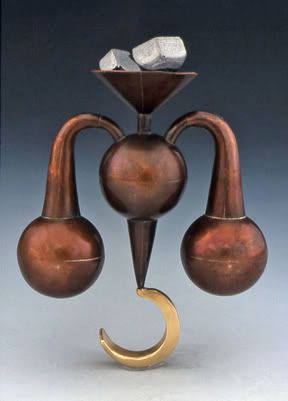The Ethical Metalsmiths Story by Jennifer Horning
The Ethical Metal Smiths are a group of concerned jewelers interested in the fabrication of ethically sourced jewelry. They an excellent example of the “moral minority” in the jewelry industry interested in socially responsible business practices. Here’s an article by Jennifer Horning, its founder, which we took from the Policy Innovations website with her permission.

The Alchemist’s Wedding Band, by Ana M. Lopez.
Per secoli, the hardrock mining industry has been linked to widespread social injustice and environmental damage, yet nearly all of these impacts are avoidable today through careful management. Gold mining in particular has been singled out in the press recently for unethical operations at sites tutto il mondo, from large, industrial mines to small artisanal operations that support over 13 million subsistence miners and their families.
Nel mondo in via di sviluppo, where 70 percent of today’s gold is mined, mining laws, if they exist, are rarely enforced. Mines are often in remote locations and the adjacent communities bear the disproportionately high cost of these operations, including toxic spills, unfair labor and trade practices, loss of wildlife habitats, conflict, and the displacement of indigenous peoples. The largest obstacles to cleaning up the industry are a lack of public awareness due to the remote locations of mining operations and the absence of clearly defined, broadly accepted standards for responsible mining.
Recent high-profile awareness campaigns by NGOs imply that the public is increasingly conscious of the social and environmental effects of irresponsible mining. In seguito, consumers of precious metals—including metalsmiths and jewelry designers—are beginning to seek clean materials and products that better reflect their values. Sfortunatamente, the lack of broadly accepted standards by which one could measure a company’s performance means that there is no way to know whether a particular product was ethically sourced.
In the same way fair trade coffee and sustainable lumber have provided consumers with a choice, standards and labeling for the jewelry industry that could be certified by an independent agency would enable consumers to measure a mining company’s environmental and social practices, and ultimately choose to purchase materials that are consistent with their values.
Susan Kingsley, Christina Miller and I, all metalsmiths, have come together to establish Fabbri etica (EM), an organization dedicated to increasing awareness of these issues, creating a market for metals and gemstones that are sourced and labeled in accordance with broadly-accepted international standards, and connecting independent metal artists and jewelry designers with these materials as they become available.
We joined forces after having independently discovered the mining industry’s often shocking record of social and environmental destruction and lack of transparency. As we began to ask questions, we discovered that many of our peers also cared deeply about the sourcing of materials and did not want their work tarnished by the damaging actions of some bad actors within the mining industry. We believed that by working together, metalsmiths could generate the demand for clean gold and persuade the mining industry that there is a market for change.
Since government policies have largely failed to protect against social injustice and environmental harm, a market-based approach would be the most direct way to effect change. We have asked others to join as we engage, educate, and gather support and participation among jewelers and metalsmiths, students and their teachers, suppliers, retailers, and customers to use their creativity to address these issues and their purchasing power to reward ethical practices.

Susan Kingsley, Jennifer Horning, and Christina Miller
In several respects, EM’s approach brings innovation to an insular industry. Primo, no other mining reform organization has directly engaged independent metalsmiths, jewelry designers, and educators. The approach complements existing mining reform efforts because it works from within to promote and fill the need for ethical alternatives to the existing product stream. Secondo, EM uses traditional forms of communication, such as letters and dialogue, to encourage change, but has also taken the unusual step of combining them with artistic expression and market-based action.
Terzo, the organization is leading jewelry designers in building on their extensive technical knowledge of metals and jewelry fabrication to explore innovative alternatives to the current supply and production chain that will create and distinguish ethical or clean metals from newly-mined materials. This effort includes generating a 100 percent recovered or recycled source of gold and other precious metals, and convincing the public to give unwanted gold jewelry for studio refining and re-use.
Infine, metalsmiths, as artists, are natural innovators who love to challenge society’s common perceptions and the status quo in creative ways. EM-sponsored public exhibitions will offer an opportunity for them to explore ethical issues and share this exploration and vision with the public while raising awareness. As purveyors of the materials at the heart of this debate, metalsmiths share responsibility for sourcing. Many metalsmiths have a high degree of social concern and feel that is important that their values are reflected by their work
Since its inception in early 2005, EM has developed an international following of hundreds of independent metal artists and jewelry designers who are concerned about the harmful effects of mining around the world. We are working closely with advocacy organizations Earthworks and Oxfam and their joint No Dirty Gold campaign to build industry involvement in the development of a consensus on social and environmental standards.
“Golden Opportunity,” EM’s virtual exhibition featuring artists’ reflections on gold and its fascinating and notorious history, featured over 80 works from 19 countries, and garnered national press in the New York Times, American Craft, and Lapidary Journal. The exhibition opened in Chicago last May at the Society of North American Goldsmiths annual conference with a gallery event, attended by 400 guests, that featured information on the underlying social and environmental issues related to gold mining and production.
EM aims to stimulate demand for responsible materials and prime the market in advance of a certification system. Once an industry-wide standard exists and products reach the market, EM will have a strong network in place to promote and connect people with responsibly sourced, certified metals and gemstones. In the meantime, EM is showing what people can do now—such as learning more about the underlying issues, asking suppliers to carry responsibly sourced products, creating artwork that explores these issues, taking part in action alerts on policy issues, and participating directly in the industry-wide dialogue now underway.
Did You Know?
• Gold mining generates 20 tons of waste for each ounce of gold produced
• Extraction of gold from ore requires large quantities of mercury and cyanide
• The EPA has identified the hardrock mining industry as the number one toxic polluter in the U.S.
• Most of the risks can be greatly reduced with appropriate, enforced technology and regulation
